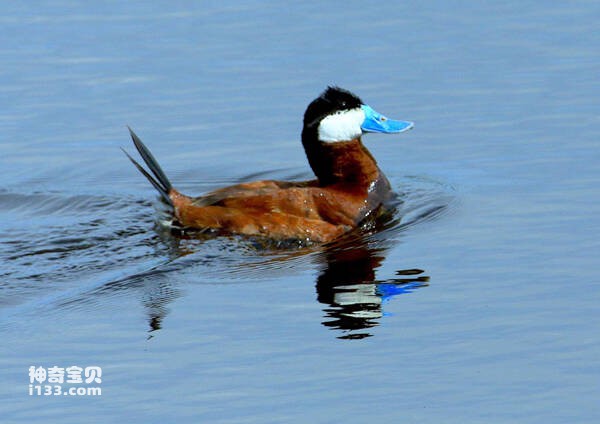Oxyura jamaicensis
IUCN
LCBasic Information
Scientific classification
- name:Oxyura jamaicensis
- Scientific Name:Oxyura jamaicensis,Ruddy Duck
- Outline:Waterfowl
- Family:
Vital signs
- length:36-40CM
- Weight:560-590g
- lifetime:No textual research information is available
Feature
The drake has a black cap that extends from its eyes to the nape of its neck, white cheeks all year round, bright reddish-brown plumage in summer, a white underbody, and a blue bill
Distribution and Habitat
Found in Anguilla, Antigua and Barbuda, Bahamas, Barbados, Bermuda, Bonaire, Saint Eustatius and Saba, Canada, Cayman Islands, Cuba, Curacao, Dominica, Dominican Republic, El Salvador, Guatemala, Haiti, Honduras, Jamaica, Martinique, Mexico, Montserrat, Nicaragua, Puerto Rico, Saint Kitts and Nevis, Saint Lucia, Saint Vincent and the Grenadines, Saint Martin (Netherlands Department) Turks and Caicos Islands, Virgin Islands.
Introduced in: Austria, Belgium, Denmark, France, Germany, Iceland, Ireland, Morocco, Netherlands, Norway, Portugal, Spain, Sweden, Switzerland, United Kingdom.
Travellers: Algeria, Finland, Grenada, Guadeloupe, Hungary, Israel, Italy, Saint Pierre and Miquelon, Slovenia, Tunisia, Turkey.
It breeds in Canada and the northern United States during the summer. During the breeding period, it mainly lives in freshwater lakes in open plain areas, especially in some shallow lakes and ponds near large lakes, especially freshwater lakes with shore plants and emergen
Appearance
The female's head is dark brown from the crown of the forehead and above the eyes to the nape of the neck, with brown feather tips and a white stripe under the eyes from the base of the bill to the occipital, with a black stripe under the white stripe. The cheeks, throat and foreneck are yellowish-white with dark spots; Lower neck and lower body mostly brown, with dark subterminal spots. The central abdomen of the lower body and the lower tail are covered with yellowish-white feathers, mixed with dark spots. The underback, waist and tail coverts are grayish brown, with dark stripes; The wings and tail are male. The female's winter plumage is darker and less brown, the sides of the head are whiter, and dark spots on the cheeks are more pronounced.
Juveniles and females have similar winter plumage, but the head cheek spots are more prominent, the side of the head is whiter, the upper body is darker, and the lower body is more yellowish.
Iris yellow or orange in male, ligh
Details
The Ruddy Duck (Oxyura jamaicensis) has three subspecies.

The brown duck's swimming, diving and flying posture is more like that of a grebe than that of other ducks. They do not travel on land and rarely fly. Can sleep in the wind and waves. They mingle with other ducks and are good at swimming and diving. When swimming, the tail is often raised high. When taking off from the water, it often skimmed over the water for a considerable distance before it had to leave the water.

Listed on the International Union for Conservation of Nature (IUCN) 2012 Red List of Threatened Species ver3.1 - Not Threatened (LC).
Protect wild animals and eliminate wild meat.
Maintaining ecological balance is everyone's responsibility!








